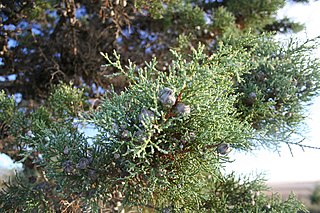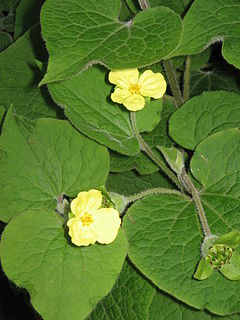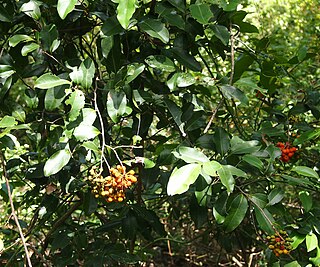
Hornbeams are hardwood trees in the flowering plant genus Carpinus in the birch family Betulaceae. The 30–40 species occur across much of the temperate regions of the Northern Hemisphere.

Cypress is a common name for various coniferous trees or shrubs of northern temperate regions that belong to the family Cupressaceae. The word cypress is derived from Old French cipres, which was imported from Latin cypressus, the latinisation of the Greek κυπάρισσος (kyparissos).

Ulmus castaneifoliaHemsley, the chestnut-leafed elm or multinerved elm, is a small deciduous tree found across much of China in broadleaved forests at elevations of 500–1,600 metres (1,600–5,200 ft).

Ulmus szechuanicaFang, known as the Szechuan (Sichuan), or red-fruited, elm, is a small to medium deciduous Chinese tree found along the Yangtze river through the provinces of Sichuan, Jiangxi, Anhui, and Jiangsu.

Kniphofia uvaria is a species of flowering plant in the family Asphodelaceae, also known as tritomea, torch lily, or red hot poker, due to the shape and color of its inflorescence. The leaves are reminiscent of a lily, and the flowerhead can reach up to 1.5 m (5 ft) in height. There are many varieties of torch lily, and they bloom at different times during the growing season. The flowers are red, orange, and yellow.
The red-tailed knobby newt or Kweichow (crocodile) newt is a species of salamander in the family Salamandridae. It is found in western Guizhou and north-eastern Yunnan, China. It is most closely related to emperor newt and Himalayan newt.
Adiantum fengianum is a species of maidenhair fern endemic to China. Its natural habitat is temperate forests. It is threatened by habitat loss.

Helicia is a genus of 110 species of trees and shrubs, constituting part of the plant family Proteaceae. They grow naturally in rainforests throughout tropical South and Southeast Asia, including India, Sri Lanka, Indochina, Peninsular Malaysia to New Guinea and as far south as New South Wales.
Helicia shweliensis is a species of plant in the family Proteaceae. It is endemic to China, where it is confined to Yunnan. It is threatened by habitat loss. The causes of habitat loss are attributed to a variety of factors, but the most prevalent factors include the destruction of forests in favor of constructing plantations for the production of cash crops.
Monocyclanthus is a monotypic genus of flowering plants in the family Annonaceae containing the single species Monocyclanthus vignei. It is native to Ghana and Liberia. It is a rare plant of the understory of wet evergreen forest habitat.
Disepalum plagioneurum is a species of plant in the Annonaceae family. It is found in China and northern Viet Nam.

Saruma is a monotypic genus of flowering plants in the family Aristolochiaceae containing the single species Saruma henryi. It is endemic to China, where it occurs in Gansu, Guizhou, Hubei, Jiangxi, Shaanxi, and Sichuan.
Aleuritopteris albofusca is a species of fern in the family Pteridaceae. It is endemic to China, including Tibet. Its natural habitat is subtropical or tropical dry forests. It is threatened by habitat loss.

Uvaria is a genus of flowering plants in the family Annonaceae. The generic name uvaria is derived from the Latin uva meaning grape, likely because the edible fruit of some species in the genus resemble grapes.

Uvaria leichhardtii, commonly known as zig-zag vine, is a species of vine in the family Annonaceae. It is native to parts of Malesia, New Guinea, and the eastern Australian states of Queensland and New South Wales.
Bacchisa kweichowensis is a species of beetle in the family Cerambycidae. It was described by Breuning in 1959. It is known from China.
Neo-uvaria is a genus of flowering plants belonging to the family Annonaceae.

Uvaria grandiflora is an Asian liana species in the family Annonaceae and tribe Uvarieae. Its native range includes: China, Indochina, Malesia and New Guinea.

Uvaria macrophylla, also known by its common name large-leaved uvaria, is a species of flowering plant in the family Annonaceae. The species was originally described by William Roxburgh in 1832. The name is a synonym of Uvaria littoralis (Blume) Blume.











